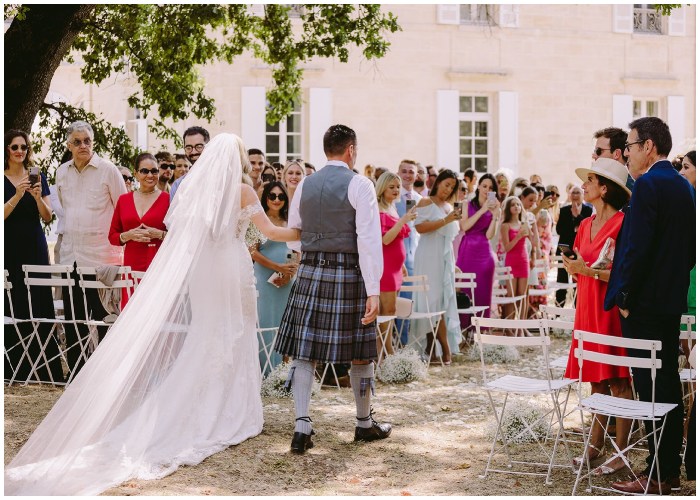Your wedding day is a celebration of love and unity, but for many couples, it’s also an opportunity to honor their cultural heritage. Modern weddings have evolved to blend diverse traditions beautifully, creating unique ceremonies that reflect not just the couple’s love story but also the legacy of their roots. This is especially significant for destination weddings in places like France, where couples often merge local customs with their own. By incorporating meaningful cultural elements into your design, you can craft a personal, inclusive, and unforgettable wedding. From rituals to attire, here’s how you can thoughtfully weave cultural traditions into your modern wedding design.

Understanding the Meaning Behind Cultural Traditions
Before adding cultural elements to your wedding, take the time to understand their significance. Every tradition has a story, and respecting these origins ensures they are integrated in a way that honors their meaning. Start by speaking with family members who can offer insights into rituals or symbols that hold value. Research can also help you uncover the historical context of specific practices, making it easier to adapt them to your wedding. Whether it’s a particular ceremony or a symbolic motif, this groundwork ensures your wedding is respectful and meaningful. Knowing the “why” behind each tradition will deepen your connection to the day and create an event that resonates with all your loved ones.
Infusing Culture Into Your Wedding Ceremony
The wedding ceremony is the heart of the celebration, making it the perfect place to highlight your cultural heritage. Many traditions lend themselves beautifully to a modern wedding; blending them can create a seamless experience. For example, an Indian ceremony might include the vibrant colors of a Mandap or the ritual of Saptapadi (seven steps). In contrast, a Jewish ceremony could feature a chuppah and glass breaking. Similarly, the Chinese tea ceremony, where couples serve tea to their elders as a sign of respect, can be a touching addition. African customs, such as jumping the broom or tying the knot with braided grass, bring layers of symbolism. The key is to work with your officiant or planner to harmonize these rituals, ensuring the ceremony feels cohesive and personal.

Showcasing Heritage Through Wedding Attire
Wedding attire is a powerful way to celebrate cultural traditions, offering endless opportunities to honor your roots while embracing modern style. Many brides and grooms wear traditional outfits for the ceremony before changing into contemporary looks for the reception. For example, Indian brides often wear sarees or lehengas adorned with intricate embroidery, while African brides might incorporate kente cloth or Ankara prints into their dresses. Grooms, too, can honor their heritage—Scottish grooms might wear kilts in their clan tartan, while Japanese grooms could opt for a formal montsuki kimono. By blending traditional and modern elements, couples can create looks that are uniquely their own while paying homage to their cultural identities.
Bringing Culture to Life with Music and Dance
Music and dance are essential to many cultural celebrations, and incorporating them into your wedding is a joyful way to share your heritage with guests. For instance, Indian weddings often feature Bollywood dance numbers or classical Bharatanatyam performances, while Latin American weddings might include salsa or mariachi bands. Middle Eastern weddings come alive with dabke, a high-energy group dance that engages the couple and guests alike. Irish weddings, meanwhile, often showcase traditional folk music and ceili dances. These elements create memorable moments and invite guests to participate in the celebration, making the day feel inclusive and vibrant.

Infusing Culture into Cuisine and Decor
Food and decor offer countless opportunities to weave cultural traditions into your wedding. A fusion menu can combine flavors from both heritages, such as pairing sushi appetizers with Italian pasta dishes or serving Ethiopian meals alongside French desserts. Signature cocktails inspired by cultural roots—think whisky-based drinks for a Scottish wedding or margaritas for a Mexican celebration—add a personalized touch to the beverage menu. The decor is equally significant, from floral arrangements featuring culturally meaningful blooms, like Indian marigolds or Hawaiian leis, to color palettes inspired by tradition, such as red and gold, for Chinese weddings. Adding symbolic motifs, like Celtic knots or mandalas, to table settings or invitations completes the story, making your wedding an immersive experience.
Crafting a Celebration That’s Truly Yours
Incorporating cultural traditions into your modern wedding design is about more than aesthetics—it’s a way to honor your heritage and tell your unique story as a couple. Through meaningful rituals, stunning attire, vibrant music, or carefully chosen decor, these elements add depth to your day, connecting the past with the present. By thoughtfully blending these traditions, you’ll create a wedding that resonates with everyone involved and leaves a lasting impression. Your wedding is a reflection of your journey, and by embracing your culture, you celebrate love, identity, and unity that will be cherished for years to come.